mdocod
Flashaholic
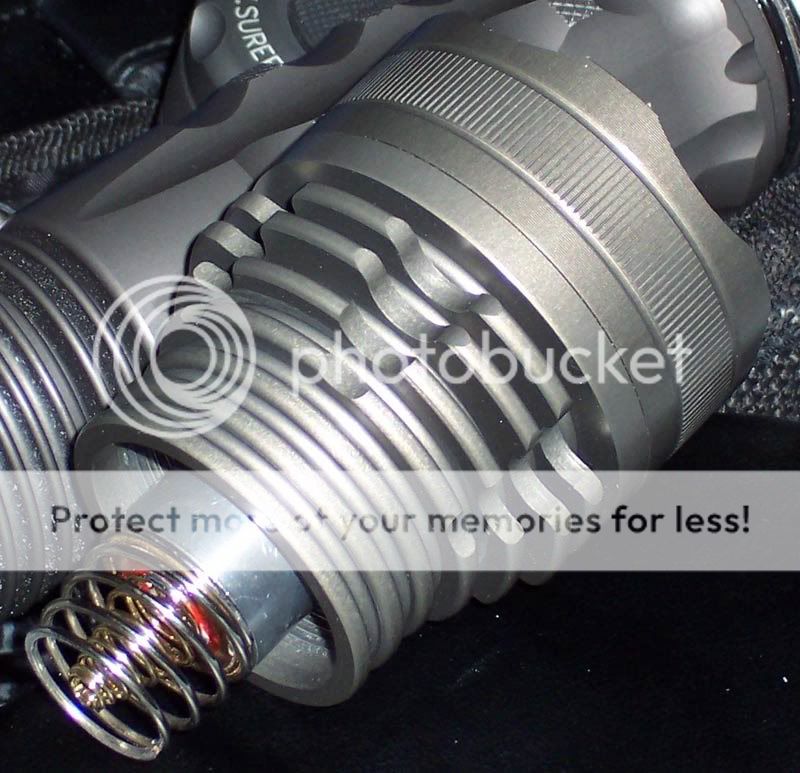
I was lucky enough to be chosen to do an evaluation of this new unit. I have had it in my possession for at least a month now and have really had a hard time keeping quiet about it. I've used it almost every day on various configurations and am convinced that the quad die emitter category is really what is needed to compete with incans. It's still *not* an incan but it has the raw horsepower to makeup for a lot. Lets check it out....
From the LumensFactory Website:
-6V-13V Regulated Input, Constant Output
-High Output SSC P7 LED, D Bin (Max Output 950 Lumens)
-6V to 13V Regulated Input for Maximum Flexibility
-High Output Single Mode
-Maximum Current Output at 2800mA
-HA 3 Anodizing on the Head Unit.
-Constant Output
-Unique Reflector Design
-Precision Machined Aluminum Reflector
-High Temperature Resistant Light Orange Peel Coating
-Every Reflector Module is Pre-Focused for the Ultimate Spot
-Compatible with all Flashlights with M Series Sized Head Units.
Compatible with:
Surefire®
M3, M3T, M4, M6
Lumens Factory®
Seraph SP-6, SP-9 with M Adaptor Installed
***Warning: This Head Unit will NOT fit Surefire M2 or P/G/Z Series lights even with a M Adaptor .***
Price: $98
Here's a picture of the unit installed on a LumensFactory SP-9 body with the C-M adapter:
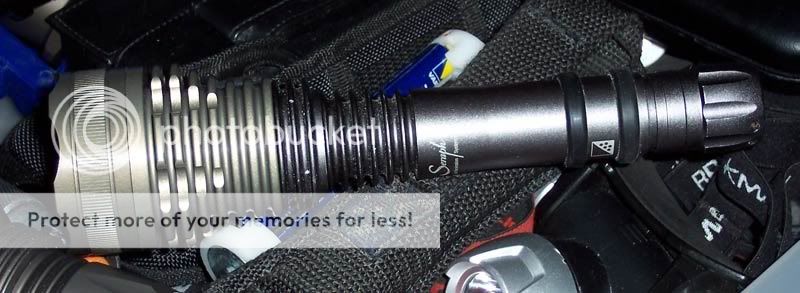
Here's the unit on a SureFire M6:
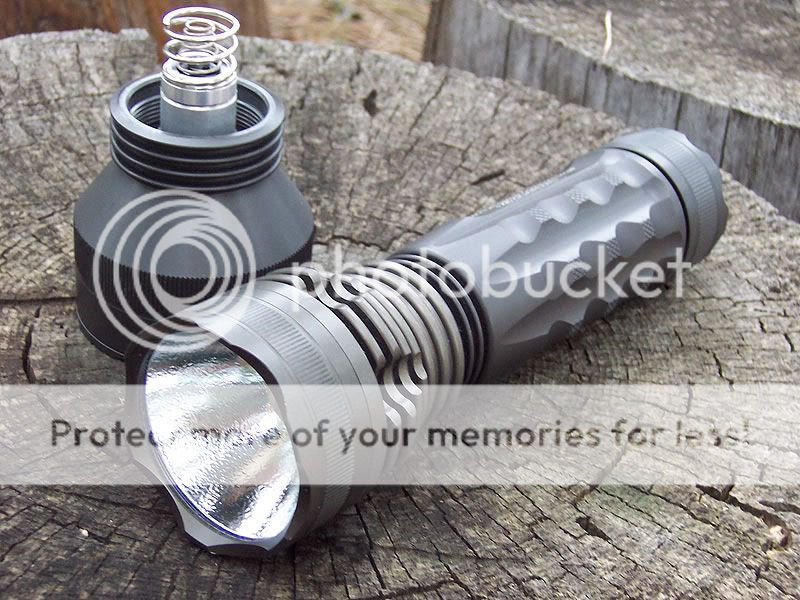
I think the unit looks really neat. It comes across to me as having a fairly unique look. The overall quality of the unit is pretty decent. The finer details of the machine work at the business end make it look at home on high end lights. It feels solid and has substantial mass to it. This is LumensFactory's first foray into HA3 "fine" quality components and I'd say they pulled this off nicely and are hitting a price point that makes this a no-brainer accessory for anyone with an M series SF.
Here's the unit pictured next to the Millennium Turbo Head from SureFire (Fount on the M3T, M4, M6 and included in the KT4)
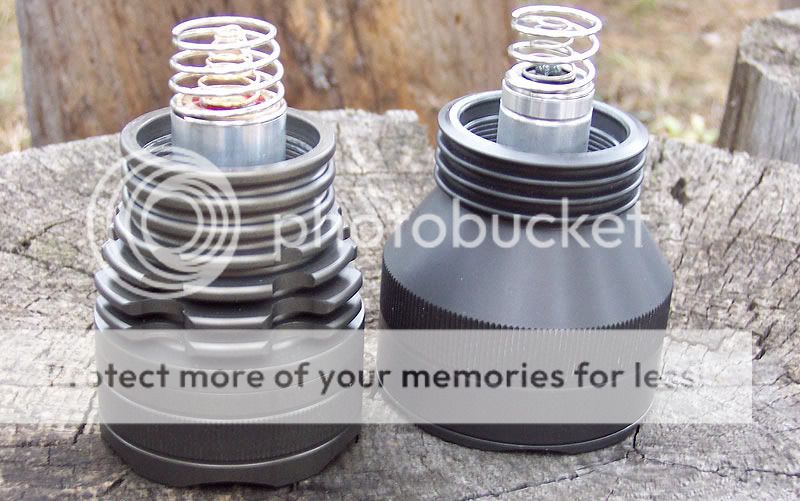
Anyone who knows anodizing understands that achieving color matching on non-colored "natural" is difficult and is effected by everything from the base material choice to many variables in the anodizing proccess. I would have liked to see a closer match to the SF parts, however, it's pretty hard to complain about color matching of a 3rd party add-on when even SF often has variances from part to part that are quite noticeable. I suppose, if you are using your light during the daytime... maybe this would be an issue though eh?....
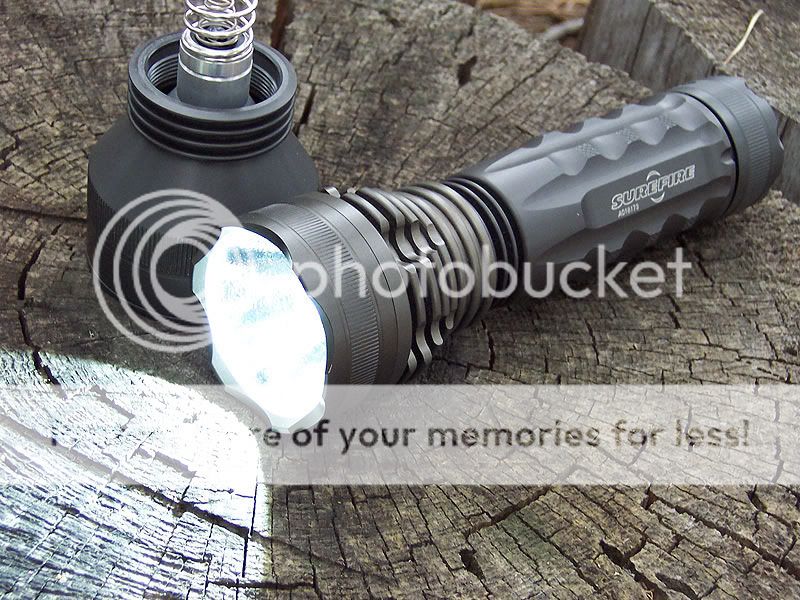
Yea, even in the middle of the afternoon, with an over-cast sky, you can clearly see the light landing on objects around you with this thing
-----
The unit uses a D bin emitter, which, according to the binning and labeling information provided by Seoul, is supposed to fall in at 800-900 emitter lumens at 2.8A. This unit runs the emitter at almost exactly 2.8A, and unfortunately, will probably never actually achieve the 950 claimed emitter lumens. I would have preferred to see the head advertised as an 850 emitter lumen unit. The exaggerated claim, is not something I'm too thrilled about. I guess the claim could have been worse...
[edit in]: I was doing a little research, and have decided that the 950 emitter lumens may theoretically be possible on some units that are on the higher end of the bin when fired up at low ambient temps before the LED heats up. While I maintain that the claim is still overly optimistic, I think it's interesting to note that this might be possible.
-----
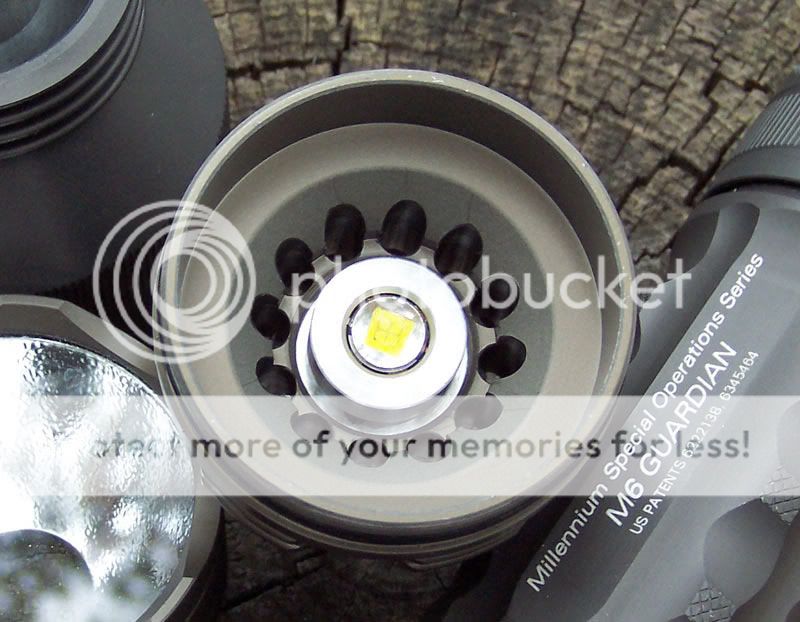
Ok... we can't complain about the heat-sinking. Plenty of aluminum and the LED is mounted on a hefty pill that is threaded into the center. As you have seen, there are nice big beefy deep fins on the outside of the unit.
I have run the light continuously for over 20 minutes on an SP-9 body. By about the 10 minute mark, the temperature stabilizes with the outside of the head at the heat-sink fins reaching around ~100F and the temperature right next to the emitter on the Pill reaching ~120F. The temperature then held steady there for the remainder of the test. This is with an ambient temp of ~70F. The maximum operating temperature for the P7 as suggested by Seoul is 185F, so I'd say there is definitely some room for higher ambient temps without reaching a thermal runaway condition. I would say that the unit is designed to operate continuously without any over-heating problems. This is certainly nice considering the numerous cheap quad-die lights on the market that do not handle heat properly and burn up the emitters in short order. No worries here, the temp not only will stay in range for the emitter but also will never rise high enough to pose any risk to your expensive collection of lithium-ion cells!
------
The compatibility of the unit and the power consumption is where things get a little complicated. Lets go over a few things about...
Physical Compatibility:
The tower module that contains the regulation circuitry is pretty fat and sticks down into the business end of the flashlight body. This creates compatibility problems on most "C" body lights. A C-M adapter is needed to fit the unit onto a C body light, but at this time, the only C body light I am aware of that will support the head as a simple drop-on is the Seraph line of lights. In some cases, the tower module itself is not the part that won't fit, but it's the outer spring, when added to the tower, that pushes it over the edge by only about 0.010". In some cases, this physical compatibility issue could be resolved through some minor modifications, or a simple swap to an outer spring made from thinner gauge steel. The body could be bored out slightly at the head to accommodate the module with the stock spring as well. Many CPFers including myself have the machining capability to do this so I think it's important to note, that while the unit is not compatible "out of the box" with a C body light, making it happen is not impossible.
I suspect that the unit should fit fine on Leef "M" bodies provided that the head end of the bodies was designed similarly to the SF bodies.
Electrical Compatibility:
The unit delivers 2.8A to the LED. Keep in mind that this is not the same as the current drawn from the power source. This is a buck regulated unit that requires a voltage input that is quite a bit higher than the Vf of the LED to operate. What's important to understand here, is that the unit needs somewhere from 6V to 13V to work properly, and that between the regulator and the LED, it will consume approximately 11 Watts. Work backwards to determine the current draw from the power source.
If you have a pair of li-ion cells. or basically, a ~7.4V power source, then work backwards: 11W/7.4V=~1.5A That would be the current drawn from the batteries and through the switch to operate the unit. I have measured ~1.4A on fresh from the charger li-ion cells, increasing to ~1.6A through the discharge. This confirms that the paper-estimate is solid.
With 3 li-ion cells, the current drops to about 1A.
So don't worry about switches, they should all be fine. I don't believe the unit is capable of drawing much more than ~1.75A-2A down around 6V supply power.
Around 6V the unit starts to drop out of regulation. From what I can tell, it seems that the unit requires an input voltage of at least ~5V to turn on. (It will not run on a single 3.7V li-ion cell unfortunately.) So, while the unit will run on a pair of CR123 primary cells, it does not run at maximum output because CR123 primary cells do not maintain 3V under these types of loads. Instead, you can expect the unit to operate at about 30-50% reduced output on 2xCR123s compared to having a 2xli-ion/3xCR123 configuration or larger.
Yes, this unit will work on the M6 with it's 6 CR123 cells. The battery adapter in the M6 has the cells wired 3S2P, so it's basically a "9V" battery pack. It will also work with the M6 pack loaded with 3.7V RCR123 cells. Or on a 2x18650 adapter, or on a 3x17670 adapter, and should also work on a Megalenium body from FM.
------
Performance:
The part you've been waiting for eh?
Take an ordinary 1A R2 D26 module and measure the lux at 1 meter, and then make a rough calculation for beam width and you get about 7-9K lux with a beam width of ~7-8 degrees, and a spill beam width of ~60 degrees. Take the same measurements on this P7 head, and you get a peak lux reading slightly higher, around 11K lux. Measure the beam width, and it's about double, ~14 degrees (covering 4x the area), and the spill, wider, at around 75+ degrees, or pretty similar to the spill angle found in most common incandecent configurations out there. A little 2x2=4 and you realize that this unit is in fact, producing some serious lumens when we have that known source of the R2 module; (they all test right around 200 torch lumen). I can say, with a good deal of confidence, that this unit probably produces around 650 or more torch lumens.
The beam pattern is extremely clean. No noticeable artifacts, no donut, smooth transition from spot to spill.
I'd compare it against a whole bunch of different stuff out there... But there's really only one bulb everyone wants to see it do battle with, the infamous MN21.
MN21:

LF P7 M:

Yes, the P7 head holds it's own here. That MN21 is being driven by a pair of Emoli cells that were charged to ~4.10V. It is technically over-driven compared to stock CR123 driven situations.
The beam patterns are slightly different. You'll notice that the MN21 produces a tighter beam profile and weaker spill. The P7 head produces a wider beam profile and much more spill intensity. These variations make almost perfect sense, when we consider the way that each unit emits light, and the size of the light source compared to the size of the reflectors. (The Millennium Turbo head is about a 2.5", the LF P7 head is about a 2"). The difference in where the lumens are going is really apparent in those pictures when looking at the illumination of the surroundings. Like the grass down low and the bush to the left.
In use, the MN21 proves more effective down range, as do many incans. In fact, many incans that have similar total power consumption as this P7 unit, will actually out-throw the unit by a fair margin. Great examples being the SR-9L D36 module, and the HO-M3 modules, both in a more compact and lighter head (~1.5" vs 2"), consume about 11W just like this unit, and generate peak lux figures half again as much as this unit. Point being, even though they are producing less lumens overall by less than half, they put more of the lumens into the central beam an less into spill. This P7 head gives you some major awareness of your surroundings in the 10-50 yard range, working better than incandecent options, beyond that, incans start to really pull ahead.
While these new quad-die emitter builds are certainly a milestone in modern LEDs, getting into major lumen territory, I feel as though there is still a lot of room for incans in portable illumination that LEDs haven't covered adequately. I'd suggest owning both
I'll try to do a few more comparison shots and toss em in here when I get a chance...
Just to throw a monkey wrench into the situation: MN21 runs for 15-20 minutes on CR123s, this P7 head will run for more like 90 minutes on the same pack.
-----
Well.. Time to get ready to head off to bed. If I think of more I want to add I'll edit it in in the coming days.
Enjoy,
-Eric
Last edited:

